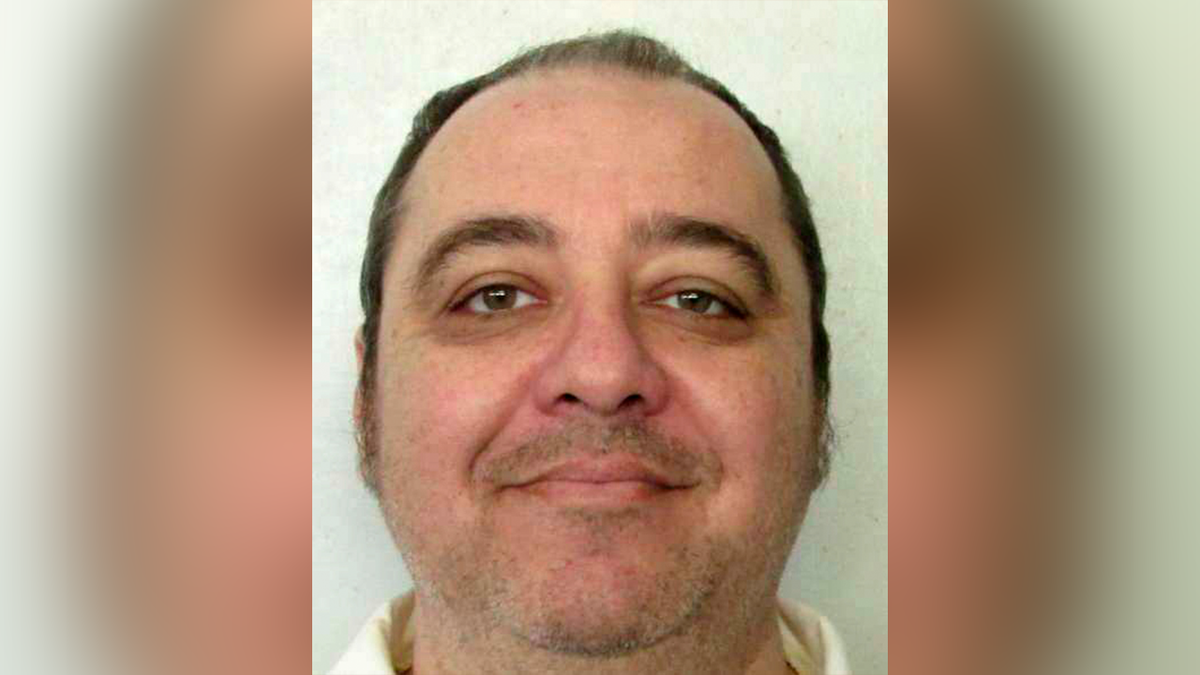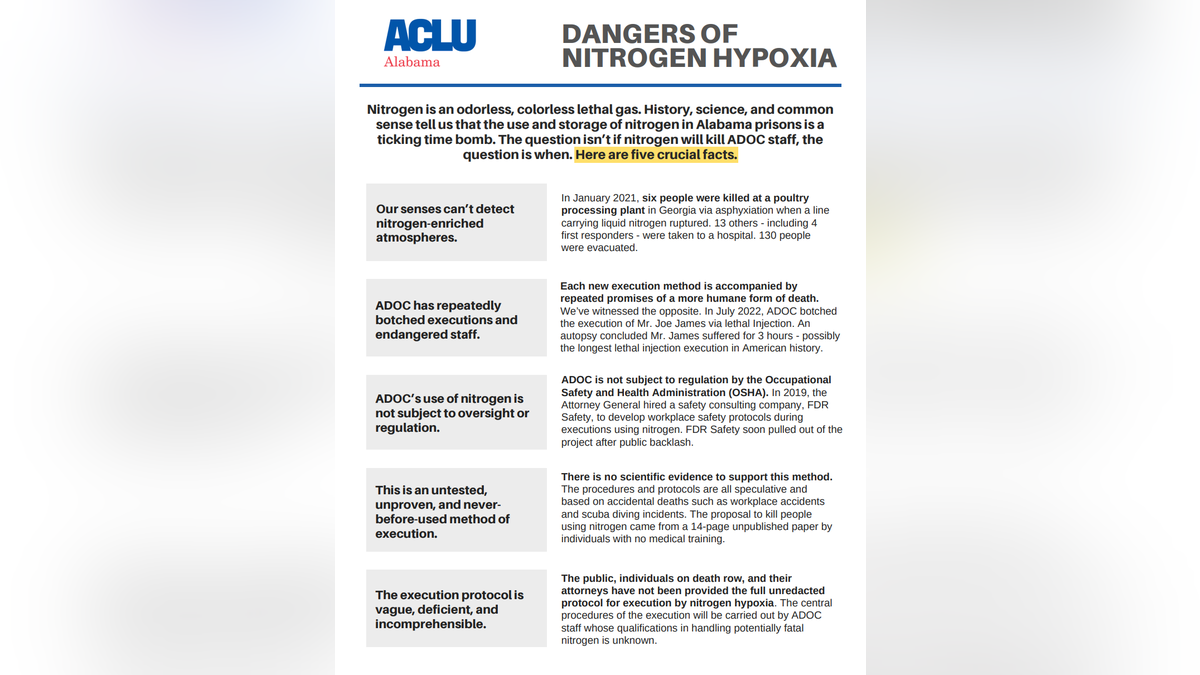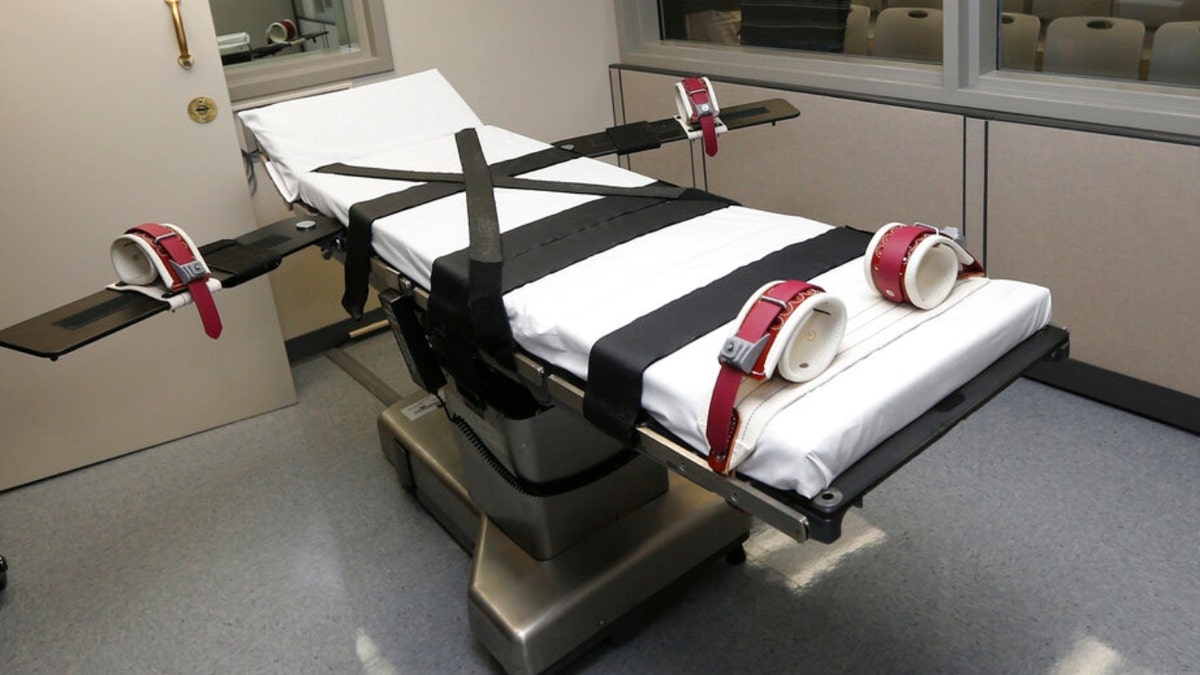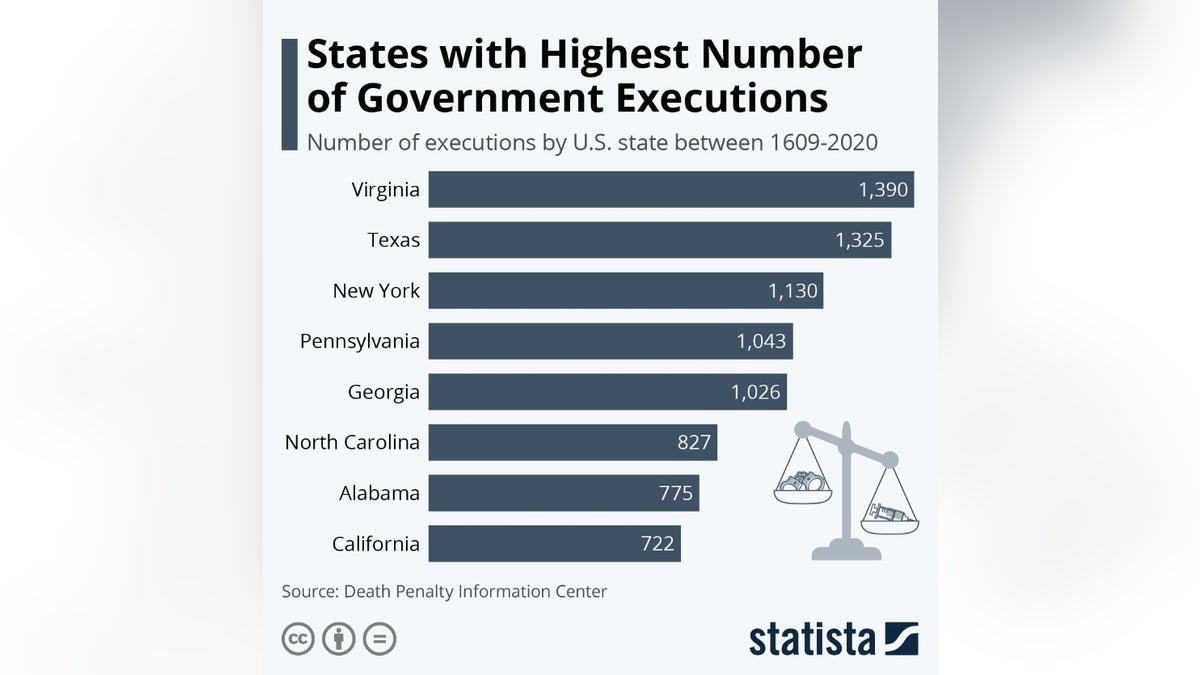Prosecutors to seek death penalty in Idaho college murders
Fox News correspondent Matt Finn reports the defense team is asking the state to share the evidence given to the grand jury that indicted Bryan Kohberger.
A death row inmate, who survived a botched lethal injection in 2022, will be the first person executed by nitrogen hypoxia, a controversial method that's untested and only authorized in three states.
One of those three states is Alabama, where Kenneth Eugene Smith, now 58, is scheduled to inhale the lethal gas for his role in a 1988 murder-for-hire plot that killed Elizabeth Sennett.
Execution by nitrogen hypoxia would cause death by forcing the inmate to breathe pure nitrogen, which deprives him of oxygen needed to maintain bodily functions. That's the theory, anyway.
But the gas' effect on humans is only recorded in medical journals about accidental exposure that has killed industrial workers or in suicide attempts, which led to criticisms that Smith is essentially being used as a lab rat.
ALABAMA INMATE WHO SURVIVED BOTCHED EXECUTION FEARS HE ‘WILL FARE NO BETTER’ IN SECOND ATTEMPT

Kenneth Eugene Smith, 58, is slated to be the first inmate to die by nitrogen hypoxia – his attorneys argue that he should not be a "test subject" of the untested, "experimental" method. (Alabama Department of Corrections via AP)
His lawyers said in court documents that their client is a "test subject" for what would be the first new method of execution since lethal injection was introduced in 1982.
The U.S. Supreme Court on Wednesday denied Smith's request for a stay of the execution, saying "The application for stay of execution of sentenced of death presented to Justice (Clarence) Thomas and by him referred to the Court is denied."
The Alabama Attorney General's Office said this new method will "cause unconsciousness within seconds, and cause death within minutes" and claimed it's "the most painless and humane method of execution known to man."
But Smith's lawyers fought back, claiming it's "inhumane," and that the mask the state will use is not airtight, which would allow oxygen to seep inside and prolong the execution or leave him in a vegetative state.
A doctor, who testified on Smith's behalf, said the low-oxygen environment could make Smith nauseous, and he could choke to death on his own vomit, The Associated Press reported.

ACLU Alabama argued against using nitrogen gas to execute death row inmate Kenneth Eugene Smith. (ACLU Alabama)
The state responded by saying the risk of vomiting was low, and Smith would be unconscious almost immediately.
The defense also argues a second execution attempt is unconstitutional after Smith was one of three Alabama death row inmates who survived a botched lethal injection in 2022.
ALABAMA JUDGE GREENLIGHTS HITMAN'S EXPERIMENTAL EXECUTION: ‘NOT GUARANTEED A PAINLESS DEATH’
"It is uncontroverted that ADOC (Alabama Department of Corrections) inflicted actual physical and psychological pain on Mr. Smith by repeatedly trying (and failing) to establish IV access through his arms, hands and by a central line as he was strapped to a gurney for hours," Smith’s lawyers said in court filings.
The 2022 attempt, which lasted over four hours, caused Smith "severe physical pain and psychological torment, including posttraumatic stress disorder."
"ADOC representatives jabbed Mr. Smith repeatedly in his arms and hands, ignoring his complaints that they were penetrating his muscles and causing severe pain, before then attempting to perform a central line procedure on him," the petition to the U.S. Supreme Court says.
READ DEFENSE'S SUPREME COURT PETITION
But five different courts – ranging from an Alabama circuit court to the state Supreme Court – have ruled against the defense's efforts to stop the execution or schedule a new hearing between May 2023 and mid-January.
Smith is set to be executed during a 30-hour window between 12 a.m. Thursday and 6 a.m. Friday.
He was convicted of capital murder for his role in a 1988 murder-for-hire plot that killed Sennett so her husband could collect the insurance money. He and John Forrest Parker killed the preacher's wife for $1,000 apiece.
Sennett's husband killed himself a week after the murder. Parker was executed via lethal injection in 2010.
What do experts say about nitrogen hypoxia?
The United Nations said it is an "untested method of execution which may subject him to cruel, inhuman or degrading treatment or even torture" in a Jan. 3 statement.
U.N. experts said there's no scientific evidence to prove Smith won't experience "grave suffering," and implored U.S. officials at the state or federal level to halt the execution, pending review of the protocol.
"We are concerned that nitrogen hypoxia would result in a painful and humiliating death," the U.N. experts said.
In the U.S., veterinarians won't use nitrogen hypoxia in euthanasia of most animals, except chickens, turkeys and pigs, according to the 2020 American Veterinary Medical Association's euthanasia guidelines.

A gurney used in giving lethal injections to convicted death row inmates. (AP Photo/Sue Ogrocki, File)
It's "unacceptable" for most mammals because it creates an "anoxic environment" that "is distressing."
To achieve unconsciousness and death, there needs to be less than 2% of oxygen, which is difficult to achieve, according to the AVMA.
‘SLASHER’ LEFT THREE GIRLS FOR DEAD AND ELUDED COPS FOR ALMOST 50 YEARS
The ACLU Alabama piggybacked off the veterinarians' guidelines in its statement released last week.
"Veterinary scientists, who have carried out laboratory studies on animals, have even largely ruled nitrogen gas out as a euthanasia method due to ethical concerns," the ACLU said.
"Attempting to kill Mr. Smith, or any other person, by nitrogen gas is cruel and inhumane. Plans to do so should be abandoned for those reasons alone."

States with the highest number of executions between 1609 and 2020. (Statista)
The legal precedents that doomed Smith's appeals
The gas will be administered for at least 15 minutes or "five minutes following a flatline… whichever is long," according to Alabama state protocol.
Dr. Joel Zivot, an anesthesiologist who was one of four experts who filed the U.N. complaint, said this puts Smith at risk for seizures and choking to death on his own vomit, and any leak under the mask could prolong the execution.
PORTLAND CHILDREN JUMP FROM STOLEN CAR, ESCAPE KIDNAPPING SUSPECT WITH GOOD SAMARITAN'S HELP
"This is clearly inhumane," Jon Yorke, a human rights professor who was part of the U.N. complaint, wrote on the Oxford Human Rights Hub. "However, proving this to the satisfaction of the U.S. capital judicial process is another matter."
The courts follow the precedents set after the U.S. Supreme Court cases of Baze v. Rees in 2008, Glossip v. Gross in 2008 and Bucklew v. Precythe in 2018.

Snippet of Supreme Court Justice Neil Gorsuch's reading of the U.S. Supreme Court's decision in Bucklew v. Precythe in 2019. (U.S. Supreme Court)
The cases essentially say the Eighth Amendment doesn't guarantee an inmate a painless death, and the burden of proof to show a certain method is inhumane was shifted from the state to the inmate.
CLICK HERE TO GET THE FOX NEWS APP
"This is a perverse requirement," Yorke wrote. "Under Baze, Glossip and Bucklew, Kenneth is effectively prevented from satisfying these standards as there is no applicable tested data on forced nitrogen gas inhalation on human subjects."



